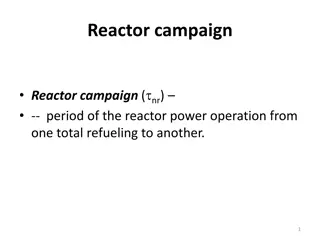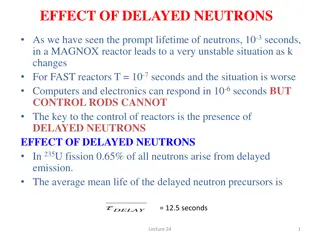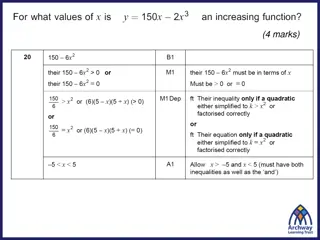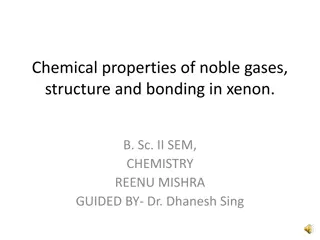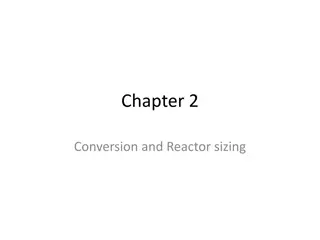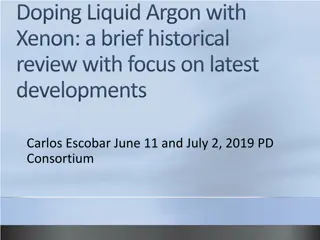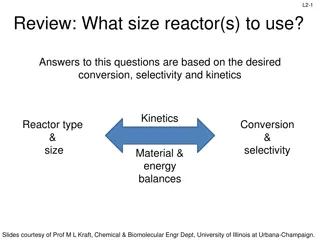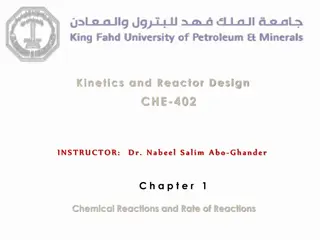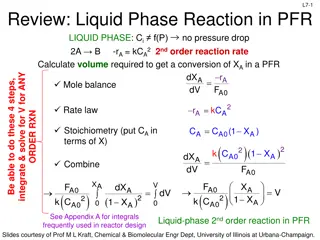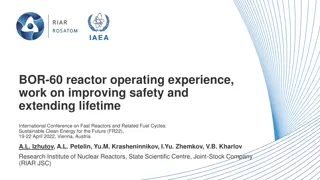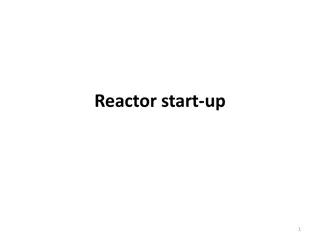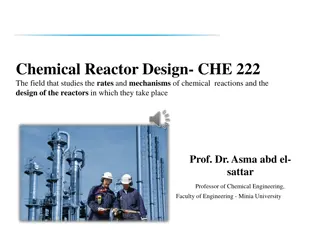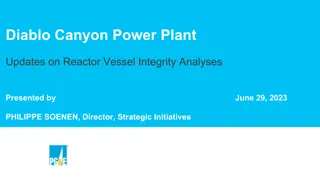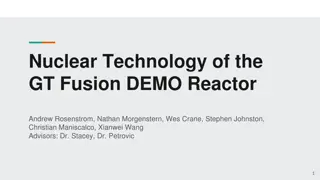Non-Stationary Reactor Xenon Poisoning When Shedding Load to Zero
In a non-stationary reactor scenario, xenon poisoning becomes a critical issue when shedding load to zero. Such conditions cause the formation of an iodine pit, potentially impacting reactor performance and safety. Understanding and managing xenon and iodine behavior during load shedding is essential for ensuring the stable operation of the reactor.
Download Presentation

Please find below an Image/Link to download the presentation.
The content on the website is provided AS IS for your information and personal use only. It may not be sold, licensed, or shared on other websites without obtaining consent from the author.If you encounter any issues during the download, it is possible that the publisher has removed the file from their server.
You are allowed to download the files provided on this website for personal or commercial use, subject to the condition that they are used lawfully. All files are the property of their respective owners.
The content on the website is provided AS IS for your information and personal use only. It may not be sold, licensed, or shared on other websites without obtaining consent from the author.
E N D
Presentation Transcript
Non-stationary reactor xenon poisoning when shedding load to zero. (Iodine pit) 1
Change of the reactor power leads to disruption of the dynamic equilibrium between increase and decrease of 135Xe. After shutdown or reduction of power there is a temporary increase of 135Xe concentration due to reduced burnup rate (due to the decrease of the neutron flux) and increase of the accumulation rate (due to excessive decay of135I). 2
135Xe concentration after the reactor shutdown increases (as (T1//2)Xe= 9.2 hours > (T1/ 2)I= 6.7 hours) until 135Xe decay starts to affect, as a result of which 135Xe concentration reduces to zero or until a new stationary value. 3
Effect of reducing the reactivity margin after shutdown or reduction of the reactor power is called iodine pit (pit is called "iodine" as 135Xe in this case is formed only as a product of iodine decay ). 4
When operating the reactors, iodine pit is highly undesirable because it is necessary to wait about 20 30 hours until 135Xe concentration returns to that which was before the reactor shutdown or to have a large reactivity margin in a normally operating reactor. This margin is used for rising a reactor located in the iodine pit to power, which is economically unprofitable and structurally difficult. 5
Consider the kinetics of 135Xe concentration changes at the instant reactor shutdown. From equations it follows that after reactor shutdown, 135I formation as well as 135 Xe burnup, stops completely. 135Xe concentration changes only due to radioactive decay of iodine and xenon accumulated in the nuclear fuel. 6
the picture changes iodine-135 and xenon-135 concentrations after reactor shutdown N(t) oNJ(t)=NJ oexp(- J t) NJ NXe(t) NXe t 0 t* .19.6. . o 7
changes iodine-135 and xenon-135 concentrations after reactor shutdown 8
Non-stationary poisoning by 135 after reactor shutdown Approximate nature of dependence Xe(t) for the reactor at its shutdown at the various capacities, when at the time of reduction of capacity equilibrium concentrations of 135I and 135Xe were established. 9
Time when 135Xe concentration reaches a maximum value and, accordingly, the loss of reactivity by poisoning is maximum, is called maximum time of iodine pit (ti.p.max) and loss of reactivity i.p.per time ti.p.maxis called iodine pit depth. 10
Forced reactor shutdown - a reactor state in which its start-up is impossible due to the lack of operational reactivity margin to compensate for the poisoning effect. 11
The most important characteristic of the said reactor state is forced shutdown time tf.s., i.e. time in which the loss of reactivity due to poisoning exceeds disposable reactivity margin in the absolute value. 12
Nuclear fuel conversion, conversion ratio Nuclear fuel conversion - the process of formation of secondary fissile nuclides in the nuclear reactor. 13
In the reactors operating by uranium, in addition to burnup of fissile nuclide 235U, nuclei of new fissile nuclide 239Pu at radiative capture of neutrons by 238U nuclei (reaction (n, )) are formed. Similarly, in a nuclear reactor, containing thorium 232Th in the core , a new fissile nuclide 233U is formed. 14
Consequently, there are cycles of nuclear fuel conversion cycle based on two types of nuclear reactions: uranium and plutonium cycle, thorium and uranium cycle: 92238U + n 92238U 93239Np 94239Pu; 23,5 2,3 91233Pa 90232Th + n 90233Th 92233U. 23,2 27,4 15
Nuclear fuel, containing 235U as a fissile component, is called primary. Nuclear fuel, containing 239Pu or 233U as fissile component, is called secondary. 16
The intensity of the nuclear fuel conversion process in the reactor is characterized by a conversion ratio Cratio, which equals the ratio of the amount of formed secondary fuel nuclei Nsecfor a certain period of time to the number of burnup nuclei Nburnup, for the same period of time: Cratio= Nsec/ Nburnup= ( burnup/ sec)( msec/mburnup) where: sec, burnup, msec, mburnup respectively, mass numbers and masses of the secondary and burnup fuel ; Nburnup considers burnup of the secondary fuel. 17
To characterize the conversion process, at a given time (at a given burnup fraction) differential conversion ratio is introduced, which is equal to the ratio of the formation rate of the secondary fuel nulei to the nuclei burnup rate Cratio,dif= (dNsec/dt )/(dNburnup/dt ) = dNsec/dNburnup dNsec/dt dNburnup/ dt, 18
Temperature effects and coefficients of reactivity 19
Temperature change of the core elements effects on the effective neutron multiplication factor and therefore reactivity. In pressurized water reactors, temperature changes of coolant, which is also moderator, have the greatest effect on reactivity, as well as changes of nuclear fuel temperature. 20
Multiplication factor varies with temperature, at least, for two reasons: firstly, with the change of nuclear properties associated with the formation of the neutron energy spectrum and the Doppler effect; secondly, due to the change of material density (primarily moderator and reflector), which leads to the change of the average neutron paths and their leakage from the reactor. 21
The dependence of reactivity on temperature defines dynamic properties of the reactor and effects on its stability. Therefore, knowledge of this dependence for each reactor is absolutely necessary. 22
For a quantitative estimation of the temperature effect on the neutron multiplication conditions, one uses the notions of temperature reactivity effect (TRE) and temperature reactivity coefficient (TRC). 23
Temperature reactivity effect Temperature reactivity effect ( t) is an integral characteristic of the temperature effect on reactivity and represents the change of reactivity on heating or cooling down the reactor at a given temperature range. 24
Temperature reactivity effect is measured the same as reactivity. In those cases, when we speak of the temperature reactivity effect of a specific reactor, we mean change of its reactivity on heating from 20 to the operating temperature: = ( 2) ( 1) = (keff2 keff1) / (keff1keff2) 25
Temperature reactivity coefficient ( , -1) is a differential characteristic of the temperature effect on reactivity and represents the change of reactivity on heating the reactor by1 : = d / dT = dkeff/ (keffdT) 26
From the operational point of view, it is better to divide and into two components - slowly changing in time with the change of temperature and operating mode (isothermal tand t) and fast tracking the change of the nuclear reactor power (dynamic, power Nand N): = t+ N; = t+ N. 27
To determine the degree of effect of separate temperature effects on the temperature reactivity coefficient , it is better to represent kefas a product of k P (P = RmodRdif- - the probability for neutron to avoid leakage). Then: = d keff/ (keffdT) = dk / (k dT) + dP/(PdT) representing k as 4 factors 28
probability for a neutron to avoid leakage = 1 / (1+ B2M2), where: B2 - geometrical parameter of the reactor; M2 - neutron migration length, expression is converted to: = 1 / (d /dT) + 1/ (d /dT) + 1 / (d /dT) + + 1 / (d /dT) - B2dM2/dT 29
Obviously, in order to analyze the temperature effect on , and therefore temperature reactivity effect, one defines the variation of each term of the formula. 30
Change of the parameters of this formula, it is due to two factors: change of the macroscopic interaction cross sections of neutrons with atomic nuclei, the rate of which increases with heating of multiplying medium; change of the core materials density, determining their concentration and, consequently, macroscopic cross-sections. 31
For the purpose of separate accounting of these factors, in the analysis of TRE and TRC dependences on temperature, TRC of VVER reactors is conventionally divided into two components. 32
It is nuclear TRE ( nuc) which determines the dependence of reactivity on microscopic cross-sections of the core materials, in case of constancy of their densities, and density TRE of ( d) which determines the dependence of reactivity on density of the core materials, in case of constancy of their microscopic cross sections. 33
Obviously, at the known nuc and d it is easy to determine the full temperature reactivity effect: = nuc+ d. Similarly, we can write: = nuc+ d. 34
General characteristics of the components of nuclear TRE. To better analyze, it is advisable to divide nuclear TRE into two components: 1) due to the change of moderator temperature and leading to a change of the spectrum hardness of thermal neutrons; 2) due to the change of fuel temperature and leading to the expansion of the resonances and dependence of the absorption cross section on energy by a neutron (the so-called Doppler effect). 36
The first component is related to the change of energy of neutrons which are in thermal equilibrium with the multiplying medium. Increase of the medium temperature (the main importance is moderator temperature) leads to a displacement of thermal neutron spectrum to higher energies. 37
Since the absorption cross section is reduced with increase of neutron energy, heating up reduces the absorption of neutrons in the reactor core. Furthermore, due to the increase of joining energy with the increase of temperature on heating neutron moderation interval is reduced. 38
The second component relates to the intermediate energy region and is not connected with the distribution of thermal neutrons at energies. It is defined by a change of the relative motion rate in the neutron-nucleus system , which increases with the growth of absolute nuclei rate on heating and decreases with a decrease of the absolute nuclei rate at shut-down cooling. 39
Change of temperature causes change of the resonance peaks of the absorption cross section of 238U nuclei, which is connected with the change of the absolute rate of thermal motion of nuclei relative to the absolute rate of neutron motion. The higher the temperature, the greater the reduction and expansion of the resonance peak. 40
Thus, regardless of the temperature, the area under the resonance peak is always constant. By analogy with optics, changing the shape of the resonances due to thermal motion of nuclei is called Doppler effect. 41
Doppler effect affects only the probability to avoid resonance capture, while displacement effect of thermal neutron spectrum, in one or another degree, affects all other multiplication characteristics. 42
Since Doppler change of the width of the resonance peaks is a consequence of fuel temperature change, and the spectral displacement of thermal neutron spectrum is caused by the change of moderator temperature, in dynamic relation these effects are non-equivalent. 43
Density temperature reactivity effect In accordance with the definition given above this effect characterizes dependence =f( ) at =const. 44
Density effect affects VVER reactivity, mainly, in the heating period after reactor start-up and in the process of reactor shut-down cooling, since in reactor operation in the power states average temperature is usually maintained constant at all power levels. 45
Power effect and power reactivity coefficient In cases when thermal conductivity of used nuclear fuel in a reactor is low (e.g. UO2 in VVER) radial unevenness of temperature distribution in the unit cell increases with increasing capacity due to increase of temperature in the center of the fuel elements. 46
As a result, average integral temperature, by the volume of the core becomes a power function and average coolant temperature is unusable argument to characterize temperature reactivity effect, since for its use it is assumed to have slight change of radial unevenness of the temperature field in the cell. 47
Therefore, along with the temperature effect characteristics used in the reactor heating and cooling down, one also applies characteristics of power reactivity effect used in the reactor operation in power states. Power effect and power reactivity coefficient are differentiated. 48
Power reactivity effect - change of reactivity as a result of reactor power change Wpin a given range at a constant flow of coolant G through the core. Power effect is measured in reactivity units and is denoted w. 49
Power reactivity coefficient - reactivity change due to the increase of the reactor power by 1% at a constant flow of coolant through the core. Power coefficient w, (1/%), according to the definition is: w= d / dWp 50



